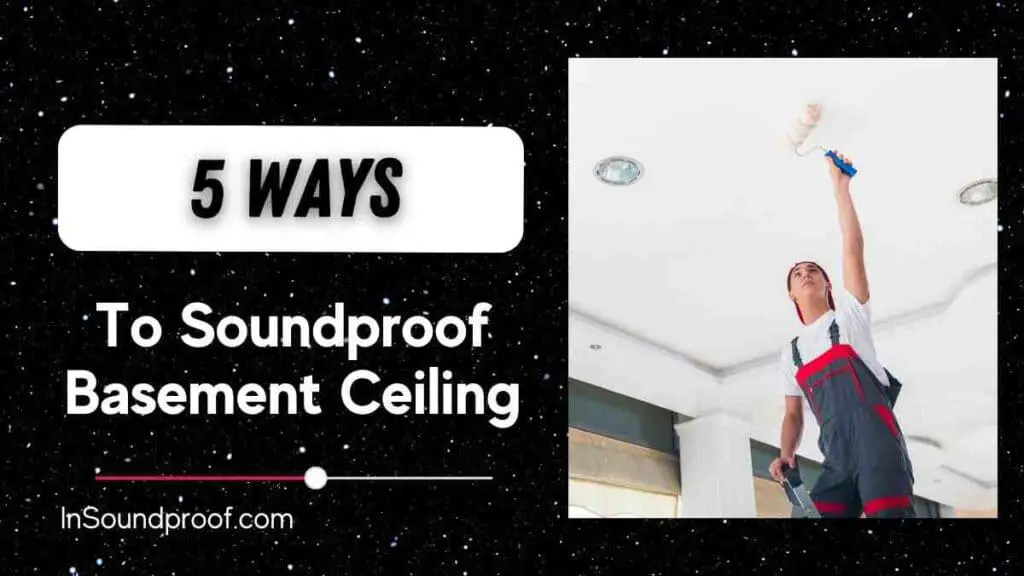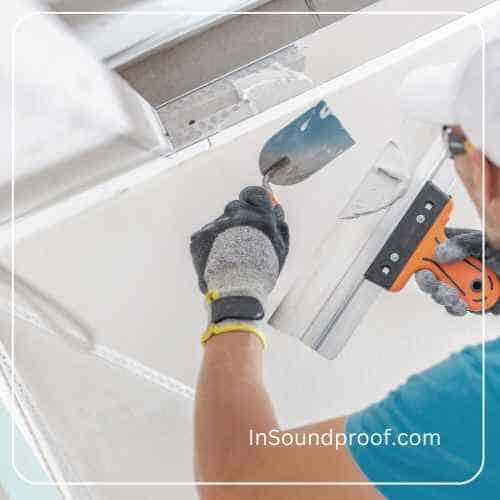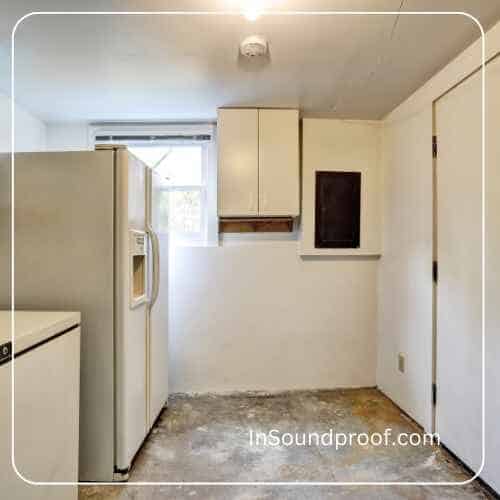Are you looking for an innovative and efficient way to soundproof your basement ceiling? Look no further!
In this article, we’ll explore the most straightforward noise reduction process to reduce reverberation and learn how to quickly create the perfect soundproofed basement ceiling!
A soundproof basement ceiling helps to dampen any outside noises from entering your home, such as traffic or other outside activities.
Additionally, basement ceiling sound insulation can help to reduce the noise caused by everyday activity inside your home. This process will create a much more peaceful and relaxing environment in your basement and help keep you from waking up early on the wrong side of the bed.
Reports show that soundproofing a basement ceiling can reduce noise by 15-30 dB (decibels) if installed correctly. The exact number depends on various factors, such as the type of soundproofing products used, their thickness/density, and how well they’re installed.
Overall, ensuring you have a well-soundproofed basement ceiling can make a huge difference in your everyday life experience at home! Installing acoustic panels and other sound-dampening materials allows you to quickly reduce the reverberation in your basement and create a much more peaceful atmosphere.
Soundproofing: How to Block Out Low Frequency Noise

Table of Contents
6 Benefits of Soundproofing Your Basement Ceiling
It is a good idea to insulate basement ceiling for soundproofing and other benefits.
Reduced noise from outside sources
The primary benefit of soundproofing your basement ceiling is that it reduces the noise from outside sources, such as traffic, loud neighbors, and other everyday activities. This creates a much more peaceful and relaxing environment inside your home, allowing you to get more restful sleep and a better quality of life overall.
Increased privacy
Additionally, soundproofing helps increase the privacy of your basement. By dampening most, if not all, outside noise from entering your home, it will be much harder for someone or something to eavesdrop on any conversations that may take place in your basement. This can benefit those who use their basement as an office or meeting space.
Improved energy efficiency
Additionally, basement ceiling sound insulation provides you with improved energy efficiency. Because the insulation dampens most of the sound, it also acts as a barrier against heat transfer from outside – keeping warm air out during the summer and trapping heat in the winter. This means you can save money on your utility bills thanks to reduced air circulation in your basement.
Better Focus
If you find yourself frequently in your basement for work or leisure, having it soundproofed will also help to reduce outside distractions. The improved seal of the basement means that you can focus more on your subject without worrying about external noises like loud conversations or traffic in the neighborhood. This makes it much easier to focus on finishing your work or relax and enjoy yourself while spending time in the basement.
Increase Mental Health
Having a basement in the home that is quiet, insulated, and soundproofed can also help to improve mental health. When you make it a place of relaxation and contemplation, having a refuge from external sources of sound and noise can provide you with an increased sense of peace, making all the difference when dealing with stress or mental health issues. A soundproof basement provides an ideal atmosphere for meditation or yoga practice, which can further promote feelings of relaxation.
Increased comfort levels
Finally, by soundproofing your basement ceiling, you can lower the temperature inside the room much quicker than would usually be achieved without any insulation present.
This means that during the hot summer months, you can keep the temperature inside your home much more comfortable and bearable, allowing you to enjoy your basement and basement activities much more.
Soundproof: How to Soundproof Interior Door
How to Identify Noise Sources

Identifying where the noise is coming from to attempt to soundproof your basement ceiling successfully is critical.
Use a basic decibel meter to measure the noise from inside and outside your home. This can help you pinpoint which areas need to be addressed.
Once potential noise sources are located, take preventative measures to reduce them further before attempting to soundproof.
Insulation around walls or replacement windows can sometimes help if external noises appear overpowering.
As for internal sounds such as voices and movement, adequate carpeting or thick curtains in your basement can also effectively lessen these noises.
5 Steps to Soundproof Basement Ceiling
My friend Mark wanted to soundproof his basement ceiling but needed to figure out how. So I gave him a few tips for tackling the project.
Step 1: Measure the basement’s ceiling size and then decide on the amount of soundproofing material you need. Consider using acoustic tiles, acoustic foam, or fiberglass insulation.
Step 2: Make sure to install the soundproofing material correctly and securely. Proper installation is vital in ensuring optimal noise reduction results.
Step 3: Consider adding mass-loaded vinyl or other materials like curtains, carpets, or rugs for added sound absorption.
Step 4: Test your finished work by playing music in the basement and measure how much noise is still coming through.
Step 5: If you still hear some noise after completing your soundproofing project, try adding more layers of material or supplement it with blankets or other items that can help absorb more noise from your basement ceiling area.
Soundproof: How to Get rid Of Low Frequency Noise
3 Soundproofing Materials for Basement Ceiling
Acoustic Tiles
Acoustic tiles are one of the most popular soundproofing materials for basement ceiling soundproofing.
These are available in different shapes and sizes and are typically easy to install. To reduce noise from entering your basement, you would attach them to your existing ceiling structure.
The tiles absorb any noise that passes through, muffling its intensity before entering your room.
Acoustic Foam
Another popular soundproofing material for basement ceiling soundproofing is acoustic foam.
Also called egg crate foam, this material effectively absorbs reverberated frequencies inside a room and low to mid-range noises from outside.
The foam cones come in various sizes, so you can choose one that best fits the space in your basement, and you can also cut the foam into smaller pieces if needed.
Fiberglass insulation
Fiberglass insulation is another good option for soundproofing material for basement ceiling soundproofing. It helps prevent noise from entering through holes or cracks in the walls and ceilings by providing a barrier between two surfaces.
You can install a layer of fiberglass insulation over an existing wall or position it directly under the surface of the wall or panel you’re trying to improve acoustics on.
You should combine soundproofing materials like acoustic tiles, egg crate foam, and fiberglass insulation for better results.
This will ensure maximum effectiveness in reducing airborne and impact noise inside your basement.
Soundproofing Unfinished Basement Ceiling Process
- Inspect the Ceiling: Before beginning the soundproofing process, inspect the basement ceiling for any air leaks, cracks, or holes. Sealing these will help prevent any sound from escaping through them.
- Insulate: Adding insulation is a great way to reduce noise from entering and leaving your basement. Several types of insulation are available, such as fiberglass batts and foam board insulation, which you can use for this purpose.
- Install Resilient Channels: Resilient channels are metal strips attached to the joists to provide a space for insulation or soundproofing material. This will help absorb and deflect sound waves away from your basement ceiling.
- Install Acoustic Panels: Acoustic panels can be installed on either side of the joists to reduce noise further coming through your ceiling. These panels are made of foam or other materials that absorb sound waves and keep them from traveling through your basement ceiling.
- Add Heavy Curtains or Blankets: Heavy curtains or blankets can also be added around windows and doors to muffle any sounds trying to pass through these wall gaps.
- Apply Acoustic Caulk: Applying acoustic caulk around the perimeter of the ceiling is an easy way to seal off further any air leaks or cracks that may exist in the walls or ceilings of your basement, thus preventing any noise from escaping through them as well as blocking out external noises from entering your space.
- Install Soundproofing Foam: Installing soundproofing foam on your basement walls is another easy and effective way to reduce noise from outside sources. The foam acts as a barrier and absorbs sound waves, thus reducing the amount of sound that comes through your ceiling.
How to Soundproof a Basement Ceiling

The unique way to soundproof a basement ceiling is to use products that absorb noise.
These can be items such as acoustic tiles, acoustic foam, and even fiberglass insulation.
Choosing suitable materials and correctly installing them is essential to achieve the highest level of sound reduction possible.
Additionally, using mass-loaded vinyl or other materials like curtains, carpets, and rugs can help significantly increase sound absorption in the room.
Create an Air Gap for Soundproofing
Creating an airflow space between the structural surface of your basement ceiling and whatever soundproof material you’re using is essential to soundproofing success.
A common way of accomplishing this is by using resilient channels between the structure and the finished ceiling surface while allowing some ventilation space.
This air gap will help reduce the sound coming through your basement ceiling.
Finally, you can also use acoustic caulk around the perimeter of the ceiling to further reduce sound waves from traveling through the structure.
Soundproofing Doors and Windows
Soundproofing doors and windows is a great way to keep loud noises from entering or leaving a room.
Heavy curtains, rugs, and blankets are great tools to muffle any sound trying to pass through these wall gaps.
Additionally, weatherstripping around doors and windows can help create an air seal and prevent noise from entering or leaving the room.
Finally, you can use acoustic seals or caulking in doorframes, window frames, or other areas around your home that might let sound through.
How to Soundproof Exposed Basement Ceiling?
There are different ways to soundproof an exposed basement ceiling.
The most common and effective way is to install resilient channels. Resilient channels are metal strips attached to the ceiling joists, providing a space for insulation or soundproofing material. This will reduce the amount of sound that can travel through the ceiling.
You can also use acoustic caulk around the perimeter of the ceiling to further reduce sound waves from traveling through the structure.
Finally, you can add heavy curtains, rugs, and blankets around windows and doors to muffle any sounds trying to pass through these wall gaps.
Soundproofing an Existing Basement Ceiling
Soundproofing an existing basement ceiling is a crucial to reduce the amount of noise that can travel through your home.
The most effective way to soundproof your ceiling is to install resilient channels and metal strips attached to the joists and provide a space for insulation or soundproofing material.
Additionally, you can use acoustic caulk around the perimeter of the ceiling and heavy curtains, rugs, and blankets around windows and doors to muffle any sounds trying to pass through these gaps in the walls.
Finally, you can add acoustic foam panels directly onto the ceiling to absorb more sound waves.
By taking these steps, you will be able to reduce any noise coming from your basement significantly.
How to Create Sound Barriers for Basement Ceilings
Creating sound barriers for basement ceilings can be done in free and premium ways.
The free options include using acoustic caulk around the perimeter of the ceiling and heavy curtains, rugs, and blankets around windows and doors to muffle any sounds trying to pass through these gaps in the walls.
Another option is to install resilient channels, which are metal strips attached to the joists and provide a space for insulation or soundproofing material.
As for premium options, you can invest in high-end acoustic foam panels that absorb more sound waves. You can also purchase specialty soundproofing materials, such as mass-loaded vinyl or acoustical sealant, to provide additional soundproofing benefits.
How to Soundproof Basement Ceiling from Upstairs Noise
One of the most effective and creative ways to soundproof a basement ceiling from upstairs noise is to install a soundproofing membrane beneath the existing drywall.
This membrane can be made out of materials such as vinyl, neoprene, or even acoustic foam.
The membrane acts as an additional layer of protection, blocking out any unwanted noise that might try to pass through the drywall in the soundproofing basement ceiling.
You can also use acoustic caulk around the perimeter of the ceiling to further seal any air leaks or cracks in the walls or ceilings of your basement.
Lastly, adding heavy curtains or blankets around windows and doors will muffle any sounds trying to pass through these wall gaps.
With these simple steps, you can quickly achieve a quiet and peaceful environment in your basement.
Summary of Soundproof Basement Ceiling
Soundproofing the basement ceiling is essential in ensuring your home is a comfortable, quiet living space.
By sealing the gaps in your ceiling, you can significantly reduce the noise and prevent sound waves from traveling through other floors of your home.
After all, nobody wants to be kept awake by loud noises downstairs!
With our range of materials and techniques, you can be sure you’re getting the best possible soundproofing solution for your basement ceiling.
9 FAQs to Soundproof Basement Ceiling
Q 1: What is the cheapest way to soundproof a basement ceiling?
Ans: The cheapest way to soundproof a basement ceiling is by using acoustic sealant, heavy curtains or blankets, and foam insulation. These materials are inexpensive and can be easily applied to the ceiling with minimal effort. Additionally, making sure to caulk around the perimeter of the ceiling will further reduce any air leaks and sound waves trying to pass through gaps in the walls.
Q 2: What are some tips for soundproofing a basement ceiling?
Ans: Some tips for soundproofing a basement ceiling include using foam insulation, acoustic sealant, and heavy curtains or blankets. Additionally, ensure that all gaps around windows and doors are sealed off with caulk so that no sound waves can pass through them. Lastly, consider adding an extra layer of drywall on top of the existing one to muffle further any noise coming from downstairs.
Q 3: What is the best sound proofing for the basement ceiling?
Ans: The best sound proofing for the basement ceiling is a combination of foam insulation, acoustic sealant, and heavy curtains or blankets. Foam insulation effectively absorbs sound waves before they can travel through the ceiling. The acoustic sealant creates a barrier between the drywall and the ceiling joists, preventing sound waves from passing through small gaps or cracks. Heavy curtains or blankets are also effective in blocking out noise as they act as an additional layer of insulation.
Q 4: Is soundproofing ceiling worth it?
Ans: Yes, soundproofing a basement ceiling is worth it. Not only can it reduce noise from upstairs, but it can also make any music or entertainment activities in the basement much more enjoyable. Additionally, soundproofing a ceiling can improve the overall acoustics of the basement and make it an even better space for entertaining or working.
Q 5: How much does soundproofing a ceiling cost?
Ans: The cost of soundproofing a ceiling will vary depending on the size of the area, materials used, and additional labor costs. Generally, you can expect anywhere from $500 to $2,000 for soundproofing a basement ceiling.
Q 6: Is spray foam good for the basement ceiling?
Ans: Yes, spray foam is an excellent option for soundproofing a basement ceiling. It is an effective way to fill gaps and cracks in the ceiling, creating a tight seal that will help to reduce noise transfer. Also, spray foam provides excellent insulation, helping keep the basement comfortable year-round.
Q 7: How can I stop hearing my neighbors through the ceiling?
Ans: There are several ways to stop hearing your neighbors through the ceiling. Adding soundproofing materials to the ceiling, such as acoustic panels or insulation, can help to reduce noise transfer. Additionally, sealing gaps or cracks in the ceiling can create a more effective barrier between floors. Finally, adding a drop ceiling with insulation can provide an additional layer of soundproofing.
Q 8: Does soundproofing in a basement music room work?
Ans: Yes, soundproofing a basement music room can be very effective. Adding acoustic panels to the walls and ceiling can help to absorb sound while adding insulation and sealing any gaps or cracks in the walls will help to reduce noise transfer. Additionally, adding a drop ceiling with insulation can provide an additional layer of soundproofing.
Q 9: How to soundproof basement ceiling without drywall?
Ans: You can soundproof a basement ceiling without drywall by adding acoustic panels and insulation and sealing any gaps or cracks in the walls and ceiling. Additionally, you can add a drop ceiling with insulation to provide an additional layer of soundproofing. Additionally, using noise-absorbing rugs on the floor and furniture can help to reduce noise transfer.

